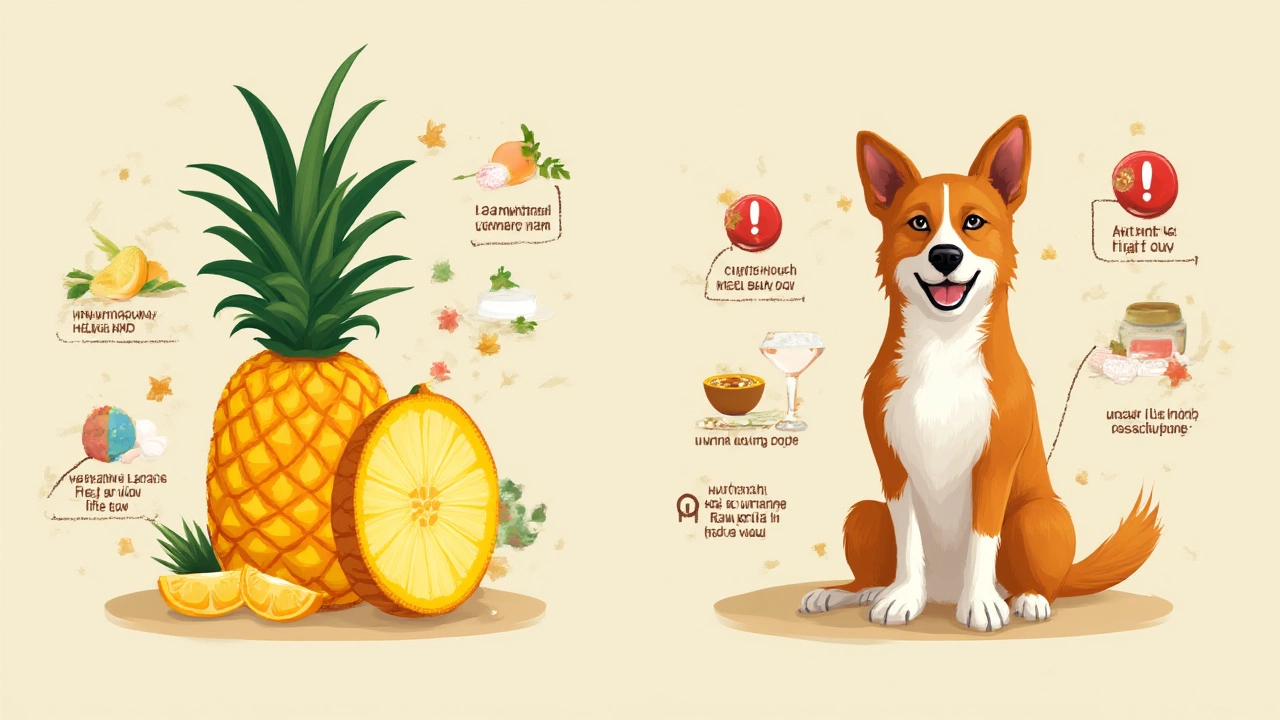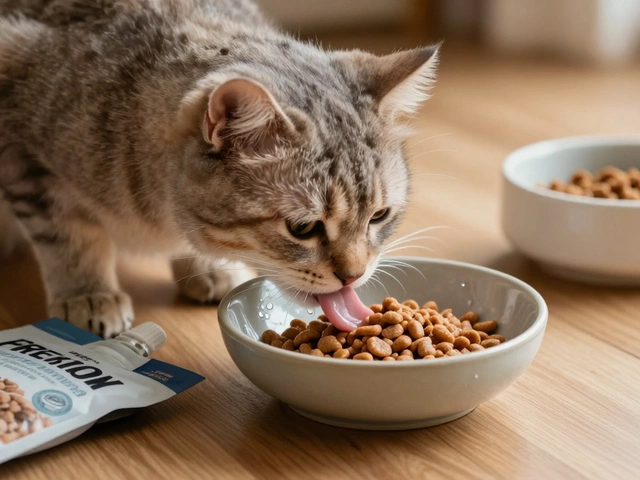
Ever split a juicy pineapple and wondered if your pup could steal a chunk? Those sweet eyes make it hard to say no, but is it safe for them? Many dog owners, myself included, have hesitated at this tropical crossroads. My dog Luna can sniff out pineapple from across the house, and honestly, she’s relentless when I start chopping. But fruit is a tricky business with dogs. Some varieties are perfectly fine. Others, one wrong bite and it’s an emergency vet visit you won’t soon forget. Let’s break down the science and straight talk about giving your dog pineapple—right from what’s actually in it, to how it affects their health and how vets feel about handing your furry friend a wedge.
Pineapple Nutrition: What’s Really Inside This Fruit?
Pineapple packs more than just a sharp bite and sweet finish. It’s loaded with vitamin C, vitamin B6, thiamin, riboflavin, and minerals like manganese, which is great for bones and metabolism. The fiber content is decent, and the water content keeps things hydrating, which can actually help with digestion on hot days. What’s unique about pineapple, though, is a little enzyme called bromelain. This stuff breaks down proteins, making it a natural tenderizer for meats (seriously, check any barbecue marinade), but it also gives pineapple some of its anti-inflammatory punch. Bromelain has been studied for its potential health perks in both humans and dogs. You’ll also find a mix of antioxidants which can, in theory, help with immune health and cell repair.
So what does this mean for dogs? Most dogs get what they need from their kibble or wet food, but adding small fruit treats can give them a little nutrition boost. Here’s a quick look at what’s actually in 100 grams of raw pineapple:
| Component | Amount |
|---|---|
| Calories | 50 |
| Water | 86% |
| Carbohydrates | 13g |
| Sugars | 10g |
| Fiber | 1.4g |
| Vitamin C | 48mg |
| Manganese | 0.927mg |
| Bromelain | Variable |
That last one, bromelain, varies based on ripeness and storage, so you never really know the exact dose your dog’s getting. Still, the vitamin and mineral combo makes pineapple a pretty solid fruit—at least on paper.
Now, dogs don’t use vitamin C the way humans do. While people need to get vitamin C from their diet, dogs’ bodies make it on their own. So, the extra vitamin C from pineapple isn't essential, but it won’t hurt in small doses. The real caution is the sweetness—10 grams of sugar per 100 grams is a big number in the dog world. Small dogs especially should only get tiny amounts to avoid upset stomachs or even weight gain over time. Big dogs have more wiggle room, but it’s still just a snack, not a meal replacement.
The Health Benefits of Pineapple for Dogs
People online toss around claims about pineapple being a miracle for dog digestion, allergies, or skin issues. What’s legit and what’s just wishful thinking? To start, the fiber in pineapple can be helpful for digestive health. If your dog is prone to constipation or mild tummy troubles, a tiny bit of pineapple here and there could help get those bowels moving. Water-rich fruits also help keep dogs hydrated, especially after a long walk or on a muggy Auckland day.
And then there’s bromelain. While the real scientific evidence goes back and forth, a few veterinary studies have suggested bromelain might help with inflammation in dogs. That can mean reduced swelling from injuries or even easing mild arthritis pain in older pooches. No one’s saying pineapple is a medication, though. It’s not going to replace your dog’s arthritis pills or fancy supplements. But as a healthy treat, it definitely ranks higher than most processed biscuits or table scraps.
Antioxidants—those tiny molecules everyone talks about online—are out in full force in pineapple too. These can help counteract free radicals, kind of like microscopic bodyguards for your dog’s cells. Some experts figure this could lead to better immune function and maybe lower risks for chronic diseases as your dog ages. Again, the numbers for real-life impact are small, but every little bit counts when you love your pup like family.
If your dog is super active, there’s a fringe benefit: the B vitamins in pineapple support metabolism, energy production, and nerve health. Dogs with big engines—they need every gear running smoothly.
A surprising bonus? Some vets say pineapple’s sharp taste can stop some dogs from eating their own poop (a nasty habit known as coprophagia). There’s no guarantee it’ll work, and the science is so-so, but plenty of dog owners have given it a try with some success. The theory is, pineapple changes the taste of a dog’s poop (I know, gross) and makes it less tempting. Worth a shot if you’re desperate!

Potential Risks and How to Avoid Them
Not every pineapple snack ends with happy tail wags. For some dogs, pineapple goes right through them, leading to diarrhea or even vomiting. That’s usually because of too much fiber or sugar in one go. Some pups are more sensitive than others, and introducing any new food should always go slow. Start with a thumb-sized piece and watch for any odd behavior in the next 24 hours.
The most obvious risk? Sugar overload. Dogs don’t digest sugar as neatly as humans. Feed too much pineapple, and you risk tooth decay, obesity, or even blood sugar spikes if your dog is diabetic. That’s why pineapples—and truly, most fruits—should always be doled out in moderation.
The real danger, though, is the core and skin. Those tough fibrous bits are nearly impossible for dogs to digest. They can lead to choking, intestinal blockages, or painful constipation. Always peel your pineapple and cut out the core before tossing any pieces to your dog. The leaves are a big no too—some dogs will chomp on anything, and the leaves can irritate the mouth or gut.
Canned pineapple is where people often get tripped up. It seems safe because it’s soft, but it almost always comes swimming in syrup. That’s a sugar disaster for dogs and should be avoided. Only use fresh pineapple or canned packed in its own juice with zero added sugar.
If your dog’s on special medication, ask your vet before throwing pineapple into the mix. Bromelain, while rare, may affect the way certain drugs are processed in the body. If your dog’s got allergies to other fruits, they may react to pineapple too—watch out for hives, itching, or face swelling after their first taste.
Bottom line: pineapple isn’t toxic, but like any new treat, it needs an adult in the room. Be vigilant with portions and keep a close eye on your dog’s reaction, especially if they’re trying pineapple for the first time.
Best Ways to Feed Pineapple to Your Dog
Pineapple’s tough skin and poky top make it intimidating, but prep is simple. Start by slicing off the skin and removing the fibrous center. Only the juicy yellow flesh is safe for your dog. For small dogs, chop pineapple into bite-sized cubes—think dice for a board game. Large dogs can handle slightly bigger chunks, but don’t get carried away.
If you want to get creative, try freezing pineapple cubes for a refreshing treat on a hot day. My Luna loves it after hikes at One Tree Hill—it cools her down and keeps her busy for minutes. You could also mash a bit and add it on top of their kibble as a topper, but don’t drown their dinner. The rule: fruit treats (including pineapple) shouldn’t make up more than 10% of your dog’s daily calories. For most medium dogs, that’s just a few pineapple cubes a day—not a whole slice.
- Always introduce pineapple gradually. A sudden flood of fruit, even just a few bites, can upset a dog’s stomach.
- Never feed the core, skin, or leaves. Enough said.
- Fresh is best. If you absolutely have to use canned, find one packed in natural juice and rinse it before serving.
- Stay close after offering pineapple for the first time. Signs something is wrong? Diarrhea, vomiting, drooling, or scratching at the mouth—call your vet if anything feels off.
- Never use pineapple as a reward for good behavior if your dog already had their daily dose. Overfeeding can sneak up on you fast.
For puppies, extra caution. Their tummies are even touchier than adult dogs, so start with a single cube, wait a day, and see how it goes. Senior dogs may benefit from the hydration but can be more sensitive to sugar, especially if they’re not as active anymore.
If you’re a DIY type, try making pineapple dog treats at home. Mix a bit of blended pineapple with unsweetened yogurt, freeze in silicone molds, and you have a cool training treat for the park. Just skip the sugar and keep serving sizes small.

Frequently Asked Questions About Dogs and Pineapple
Dog owners are a curious bunch, and the internet’s full of wild takes. Here are some clear answers to the most common pineapple-dog questions:
- “Can dogs eat pineapple?”—Yes, dogs can eat fresh, peeled, and cored pineapple in moderation. It isn’t toxic or dangerous if you follow the basic rules of prep and portion size.
- “How much pineapple can my dog have?”—A few small cubes for a medium or large dog; for little dogs, one cube is plenty. Treats like pineapple should never be more than 10% of their daily calorie intake.
- “Can puppies eat pineapple?”—Better to wait until at least six months old. Start tiny and check for digestive reaction before adding pineapple to their routine.
- “Does pineapple cure coprophagia (poop eating)?”—There’s no guarantee. Some owners have success, but it’s not a miracle fix. Worth trying if you’re out of options, but don’t count on it.
- “What about canned pineapple?”—Avoid if it’s in syrup; only use if packed in juice and rinsed well.
- “Are there fruits dogs absolutely can’t eat?”—Yes. Grapes, raisins, and cherries are definite no-go zones. Always double-check a fruit’s safety before feeding.
If you’re still unsure, don’t wing it. Ring your local vet, or check with a veterinary nutritionist—they live for these questions. Just remember, pineapple is a treat, not a meal. And for most dogs, variety (and moderation) is the spice of life—even when it comes to fruit.





